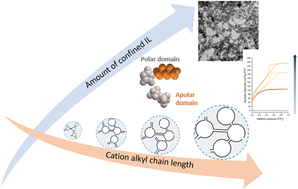Textural control of ionosilicas by ionic liquid templating†
Abstract
Due to their unique self-assembly properties, ionic liquids (ILs) are versatile soft templates for the formation of mesoporous materials. Here, we report the use of ionic liquids as soft templates for the straightforward formation of mesoporous ionosilica phases. Ionosilicas are highly polyvalent functional materials that are constituted of ionic building blocks that are covalently immobilized within a silica hybrid matrix. Ionosilicas have attracted significant interest in the last few years due to their high potential for applications in water treatment and upgrading, separation and drug delivery. The straightforward and reproducible formation of mesoporous ionosilica phases is therefore highly desirable. In this context, we report the formation of mesoporous ionosilica phases via non-hydrolytic sol–gel procedures in the presence of ionic liquids. Ionic liquids appear as particularly versatile templates for mesoporous ionosilicas due to their high chemical similarity and affinity between ILs and silylated ionic precursors. We therefore studied the textures of the resulting ionosilica phases, after IL elimination, using nitrogen sorption, small angle X-ray scattering (SAXS) and transmission and scanning electron microscopies. All these techniques give concordant results and show that the textures of ionosilica scaffolds in terms of specific surface area, pore size, pore size distribution and connectivity can be efficiently controlled by the nature and the quantity of the ionic liquid that is used in the ionothermal sol–gel procedure.



 Please wait while we load your content...
Please wait while we load your content...